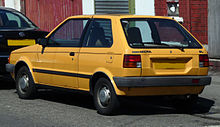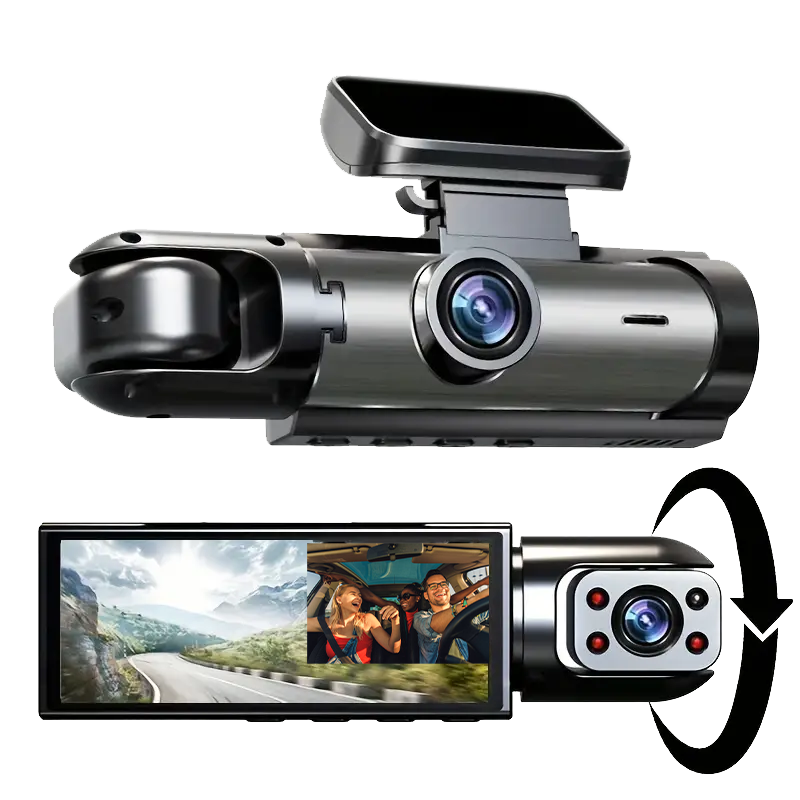
Nissan Micra First Generation 1982- 1992

| First generation (K10) | |
|---|---|
|
|
|
| Overview | |
| Also called | Datsun Micra (1983–84) |
| Production | October 1982 – December 1992 |
| Model years | 1983–1992 |
| Assembly | Oppama Plant, Yokosuka, Kanagawa, Japan |
| Designer | Naganori Ito |
| Body and chassis | |
| Body style | 3 and 5-door hatchback |
| Related | Nissan Figaro Nissan Be-1 Nissan Pao |
| Powertrain | |
| Engine |
|
| Transmission | 4- or 5-speed manual 3-speed automatic |
| Dimensions | |
| Wheelbase | 2,300 mm (90.6 in) |
| Length | 3,785 mm (149.0 in) |
| Width | 1,560 mm (61.4 in) |
| Height | 1,395 mm (54.9 in) |
| Curb weight | 635 kg (1,400 lb) |
Micra K10

Pre-facelift Nissan Micra
The original Micra (chassis name K10) was introduced onto the Japanese market in October 1982 as a challenger to the Honda City, Daihatsu Charade, Suzuki Cultus, and Toyota Starlet. It was intended to replace the Nissan Cherry as the company's competitor in the supermini sector, as the Cherry model sold in Europe had progressively become larger with each successive generation. In Japan, it was exclusive to Nissan Cherry store locations, as the Japanese market Cherry was renamed March, benefiting from engineering contributions from Nissan's 1966 acquisition of the Prince Motor Company, who originally developed the outgoing Cherry. The Micra had particularly low fuel consumption made possible by a specially developed engine only used in the Micra, an uncommonly high gearing, and a particularly low weight: only 630 kg (1,390 lb) in early European trim. The low weight target necessitated a minimum of insulation, meaning that early Micras were quite loud.
The bodystyle was originally designed for Fiat as a replacement for the Fiat 127, but Fiat then adopted the Giugiaro styled Uno instead. It was introduced in the European market in June 1983, and in Canada in 1984 for the 1985 model year (replacing the slightly larger Nissan Pulsar hatchbacks). Because the Micra was launched during Nissan's rebranding effort to systematically phase out the Datsun name, a small "Datsun" (ダットサン? Dattosan) appeared on the tailgate for the first two years, and in some European markets, the car was known as the "Datsun-Nissan Micra". The Datsun badges had disappeared completely by the end of 1984. The Micra was initially available with an extremely refined all-aluminium MA10S SOHC engine. European market cars developed 50 PS or 55 PS in the high compression version coupled with the five-speed option. It was also available with either automatic (called "Nissanmatic"), four-speed or five-speed gearbox. Both the automatic and five-speed manual gearboxes were unusual in a supermini at this time. The Nissanmatic model originally had a 60 PS (44 kW) version of the 1-liter engine.
It was one of several important small cars to be launched onto the European market during 1983. Also launched that year were the Fiat Uno, Peugeot 205, Vauxhall Nova (a Britain-only model which had been launched across Europe the previous year as the Opel Corsa) and the second generation of the Ford Fiesta. It sold well in Britain, being launched there in June 1983 and peaking at more than 50,000 sales for the year in 1989, and was one of the most popular imported cars of its era.
The model was revised in June 1985, identifiable by the slightly larger rear lamp clusters. The Japanese market saw the debut of the first Micra Turbo/MA10ET, where Nissan grafted a turbocharger to the small 1.0 L engine. This version was never sold in Europe, where the only engines ever available were the 1.0 and 1.2 units. The 1.2, with the larger MA12 1.2 L engine with an electronically controlled carburettor with 57 PS (42 kW), arrived in late 1987. A non-catalyzed version produced 60 PS. Another facelift came in March 1989, which consisted of some minor upgrades such as deeper bumpers, a new front grille, minor interior details, and headlight changes. This was also when the five-door hatchback version was introduced in Europe.
The Micra's chassis spawned a number of variations. The Be-1 (BK10), launched at the Tokyo Motor Show in 1985 (but not sold until 1987), was a limited edition model with a more rounded bodyshape, and only 10,000 were sold. In 1987, the canvas-topped, retro looking hatchback Pao (パオ) (PK10) was launched (also at the Tokyo Motorshow) and sold to the public in 1989; 51,657 models were sold. The canvas-topped Figaro (フィガロ) (FK10) coupé was unveiled at the same show in 1989, but not released until 1991. Because demand for the Figaro exceeded the 20,000 vehicles built, Nissan sold the car by lottery: winners could place orders for the car. Despite being a JDM-only model, the Figaro is one of the most imported models of the K10 derivatives; its popularity among numerous celebrity owners helped it earn cult status. The K10 ceased production on 21 December 1992, although its replacement had gone into production some months earlier.
During its lifetime, the Micra gained a good reputation for reliability and economy. In 1995, it topped the small car class in a reliability survey of four to six-year-old cars undertaken by the German Automobile Association (ADAC), with 7.5 recorded breakdowns per 1,000 vehicles for four-year-old Micras and 11.5 for six-year-old cars: this compared with 8.0 breakdowns per 1,000 cars for four-year-old Volkswagen Polos and 15.3 for six-year-old Polos. (The class loser was the Fiat Uno with 20.7 breakdowns per 1,000 for four-year-old cars and 37.3 for six-year-old Unos. In the longer term, the Micra would also go on to achieve a much higher survival rate than many of its competitors.)
For the 1991 model year, a re-badged Nissan Sentra B12 entered Canada to replace the Micra as the Nissan Sentra Classic after Nissan announced it would not import the Micra to Canada after 1991. The Sentra Classics were built in Mexico.

